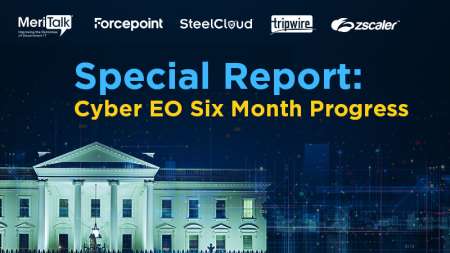The U.S. Space Force, the smallest and newest military branch, is looking to industry to serve as a leader in a number of innovative technology areas and to successfully collaborate with the service branch, according to Lisa Costa, Space Force’s chief technology and innovation officer. […]
While cybersecurity threats continue to grow and evolve, public sector organizations are worrying the most about increasing cybersecurity threats from foreign governments. […]
While the Federal government has been busy pouring billions of dollars into artificial intelligence (AI) technology development, it’s time to take stock of those efforts and start exploring the critical questions of what that work means for Federal agencies, employees, and citizens. […]
As a very busy 2021 comes to a close, it’s time to reflect on the past year and look forward with optimism to the possibilities of the new one that’s about to begin. Rounding the corner to 2022, MeriTalk asked several experts on the industry side of Federal IT for their predictions of what the next year will bring. […]
With the holiday season upon us, we at MeriTalk wanted to spread some holiday cheer. We’ve gathered up photos of our furry friends dressed in festive attire, meeting Santa, or just enjoying some winter weather. […]
The Government Accountability Office (GAO) is sustaining a protest by Microsoft after the company complained that the National Security Agency (NSA) improperly evaluated proposals for cloud services in support of NSA’s classified and unclassified computing requirements when it awarded a contract to Amazon Web Services (AWS). […]
RegScale, a Tysons Corner, Va.-based provider of compliance automation technologies for highly regulated government and business organizations, officially launched operations on November 30 with $1.5 million of new funding. […]
The American Civil Liberties Union (ACLU) wrote an open letter to the Department of Homeland Security (DHS) opposing any efforts by the agency to expand its use of facial recognition technology. […]
The U.S. Coast Guard has selected AT&T to consolidate different data communications networks onto a single modernized data communications platform under a task order worth up to $161 million over 11 years. […]
The Federal government is cultivating artificial intelligence (AI) technology gardens across major agencies, but varying mission requirements and funding streams for those efforts are producing strikingly uneven results. […]
Since the release of the Cloud First mandate in 2011, the Federal government has been pushing agencies to modernize legacy technology and migrate to the cloud. While Cloud First evolved into Cloud Smart, agencies have historically taken a measured approach to cloud migration. On the most recent FITARA scorecard, only three agencies scored an A in the Modernizing Government Technology category. Eleven agencies scored a C or below. […]
From the frontlines to the home base, our nation’s warfighters must be connected at all times to enable information sharing and support joint decision-making. To deliver on these goals, the Department of Defense’s Joint All-Domain Command and Control concept – or JADC2 – aims to connect all military services on a single network. […]
The National Institutes of Health Information Technology Acquisition and Assessment Center (NITAAC) will need to rework some requirements in its $50 billion Chief Information Officer-Solutions and Partners 4 (CIO-SP4) IT services contract, after the Government Accountability Office (GAO) partially sustained a bid protest. […]
Federal mandates, including Cloud Smart and the Biden administration’s cybersecurity executive order, are pushing agencies to modernize and migrate to the cloud. But with modernization comes complexity. Agencies are increasingly living in a hybrid world, with some workloads remaining on-premises while others move to the cloud. Add multi-cloud vendors to the mix, and it becomes harder for agencies to have a holistic view across their environments. […]
Worldwide, the number of web applications quintupled over the last decade, and the number of records compromised by data breaches grew even faster. Two in every five breaches originate in a web app, according to Verizon’s 2021 Data Breach Investigations Report. No organization is immune, especially as businesses and agencies of all sizes continue developing their own custom web apps – and continue widening their attack surface in the process. […]
The National Guard has hired Martin Akerman as its first-ever chief data officer, according to Akerman’s LinkedIn. […]
Palo Alto Networks recently issued a report detailing a targeted attack campaign that leveraged leased infrastructure in the U.S. to scan hundreds of vulnerable organizations, which compromised at least nine global entities in the technology, defense, healthcare, energy, and education sectors. […]
The Biden administration’s Cybersecurity Executive Order (Cyber EO) issued in May 2021 marks the Federal government’s most determined effort yet to not only propose – but also to enforce through sustained government-wide action – the kinds of fundamental changes needed to advance civilian agency cybersecurity, defeat sophisticated attacks on government networks, and in the process, take a giant leap forward in the cause of IT modernization. […]
The Department of Homeland Security (DHS) has pushed back the timeline for awards under its $10 billion contract for small business IT hardware, software, and managed services, and now expects to make awards in August 2022. […]
The Senate late last week confirmed President Biden’s nominee Robert Santos to be the next director of the U.S. Census Bureau. […]
The Centers for Disease Control and Prevention’s (CDC) National Institute for Occupational Safety and Health (NIOSH) issued a request for information (RFI) seeking feedback on centers of excellence for personal protective technology (PPT), which includes personal protective equipment (PPE). […]
Every government agency is loaded with data that it could use to fulfill its mission more efficiently and effectively. But getting from here to there isn’t necessarily an easy proposition. Business intelligence (BI) and analytics solutions can help. […]
Teddra Burgess, senior vice president Public Sector at cybersecurity technology provider Tanium, is still relatively new to the company, but hardly so to the Federal marketplace. Throughout her career, she has held numerous leadership roles at high-profile organizations like ASG Technologies, Micro Focus Government Solutions, and Hewlett Packard Enterprise, to name a few. […]
Only 25 percent of jobs in the technology industry and less than 20 percent of all tech leadership positions are held by women – but General Dynamics Information Technology (GDIT) is leading the charge to provide the knowledge and tools to change that. […]
For many government agencies, Time Division Multiplexing (TDM) technology has formed the core of their networks for decades. Because many mission-critical operations run on TDM services, organizations often took an ‘If it ain’t broke, don’t fix it’ approach to TDM. Today, TDM technologies are at end of life – or beyond – and expertise in them is quickly dwindling. […]
The U.S. Army announced it has delayed the rollout of its augmented reality headsets, which it expected to be in use this fall, until September 2022. […]
The Federal Chief Data Officers (CDO) Council is seeking feedback on its mission and focus areas, including workforce development, in a new request for information (RFI) published on the Federal Register today. […]
Cyber threats, including ransomware attacks, are now a national security issue as bad actors target Federal agencies and our nation’s critical infrastructure. Protecting Federal agencies against these cyber threats is a national imperative, evidenced by the Biden administration’s cybersecurity executive order mandating that agencies take additional measures to secure Federal infrastructure. […]
Federal IT leaders are balancing IT spend and project prioritization while trying to drive digital transformation to modernize government operations and meet the needs of the American people. It’s a monumental task, made even more challenging in disparate and siloed working environments. Taking a holistic approach to digital transformation in government requires a shift in mindsets. […]
Bryan Rosensteel has spent more than a decade working with identity in the Federal government. As a Federal solutions architect at identity services provider Ping Identity, he advises government agencies on best practices for deploying zero trust security architecture. When President Biden issued the Executive Order on Improving the Nation’s Cybersecurity (EO), Rosensteel was positively giddy about its potential to transform the way government secures data and operations. MeriTalk sat down with Rosensteel to explore the letter and the spirit of the EO, how centralized identity, credential, and access management (ICAM) can help agencies get to zero trust, and why agencies shouldn’t inherently trust anything – not even technology. […]




























